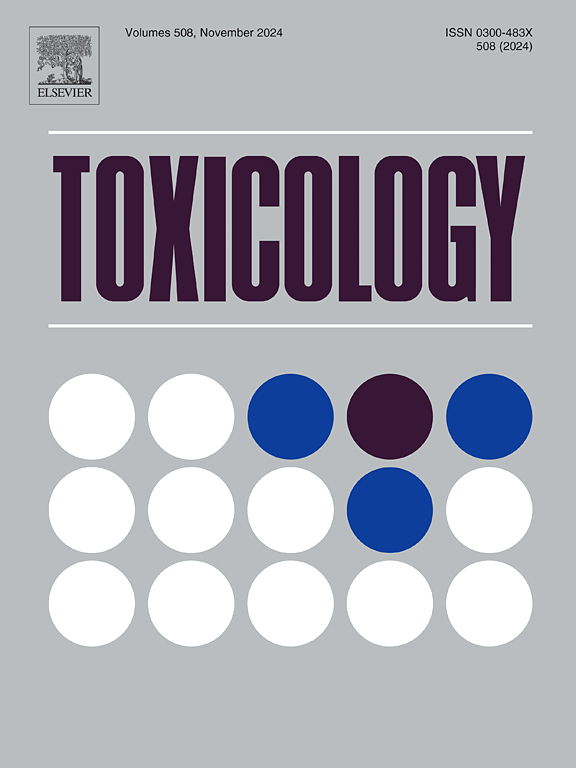右美托咪定引起的小鼠死亡不依赖于α 2-肾上腺素能受体。
IF 4.8
3区 医学
Q1 PHARMACOLOGY & PHARMACY
引用次数: 0
摘要
右美托咪定(DMED)被广泛用于临床中的镇静麻醉剂。目前,还没有针对右美托咪定致死毒性的治疗干预措施。腹腔注射(i.p.)25 至 100 毫克/千克剂量的 DMED 对小鼠的致死率呈剂量依赖性。经测定,24 小时内的 50%致死剂量(LD50)为 48.5 毫克/千克,7 天内为 44.8 毫克/千克。α2-肾上腺素能受体拮抗剂,即育亨宾和阿替帕米唑,在剂量为 44.8 毫克/千克时,对 DMED 诱导的致死毒性没有缓解作用。相反,服用阿替巴咪唑和育亨宾会增加与 DMED 相关的死亡率。相比之下,咪唑啉受体拮抗剂idazoxan和阿片受体拮抗剂纳洛酮能显著降低DMED引起的死亡率,从而延长了以44.8毫克/千克剂量(静脉注射)给药DMED后的中位生存时间。此外,免疫调节剂咪喹莫特、钙敏化剂左西孟旦和TAAR1拮抗剂RO5212773都能降低DMED引起的急性死亡率,但不影响慢性死亡率。组织病理学分析显示,暴露于DMED后,肺部会发生特征性改变,包括毛细血管出血、肺泡间隔增宽、肺泡融合和炎性细胞浸润。伊达唑蒽或纳洛酮的预处理抑制了 DMED 诱导的这些病理变化,而阿替巴唑或育亨宾的预处理则加剧了肺损伤。服用 DMED 后,血清肌酸激酶和肌红蛋白水平升高。然而,使用依达唑散或纳洛酮预处理可降低血清肌酸激酶和肌红蛋白的升高。总之,这些结果突出表明,咪唑啉受体和阿片受体参与了DMED的致死。本文章由计算机程序翻译,如有差异,请以英文原文为准。
Mice mortality induced by dexmedetomidine is non-alpha2-adrenergic receptor-dependent
Dexmedetomidine (DMED) is widely used in sedative anesthetics in clinical settings. Currently, there are no therapeutic interventions available for the lethal toxicity induced by DMED. Administered at doses ranging from 25 to 100 mg/kg intraperitoneally (i.p.), DMED exhibited a dose-dependent fatality in mice. The 50 % lethal dose (LD50) was determined to be 48.5 mg/kg within 24 h and 44.8 mg/kg within 7 days. Alpha2-adrenergic receptor antagonists, namely yohimbine and atipamezole, demonstrated no mitigating effect on the lethal toxicity induced by DMED at the dose of 44.8 mg/kg. Conversely, the administration of atipamezole and yohimbine increased the mortality associated with DMED. By contrast, the imidazoline receptor antagonist idazoxan and the opioid receptor antagonist naloxone significantly attenuated the mortality induced by DMED, thereby prolonging the median survival time following administration of DMED at 44.8 mg/kg (i.p.). Furthermore, the immune modulator imiquimod, calcium sensitizer levosimendan, and TAAR1 antagonist RO5212773 decreased acute mortality without impacting chronic mortality induced by DMED. Histopathological analysis revealed characteristic lung alterations, including capillary hemorrhage, widened alveolar septa, fusion of pulmonary alveoli, and inflammatory cell infiltrate upon DMED exposure. Pretreatment with idazoxan or naloxone inhibited these pathological changes induced by DMED, while atipamezole or yohimbine pretreatment exacerbated lung damage. Elevated levels of serum creatine kinase and myoglobin were noted following DMED administration. However, pretreatment with idazoxan or naloxone decreased the rise of serum creatine kinase and myoglobin. Collectively, these results highlighted the involvement of imidazoline receptors and opioid receptor in DMED mortality.
求助全文
通过发布文献求助,成功后即可免费获取论文全文。
去求助
来源期刊

Toxicology
医学-毒理学
CiteScore
7.80
自引率
4.40%
发文量
222
审稿时长
23 days
期刊介绍:
Toxicology is an international, peer-reviewed journal that publishes only the highest quality original scientific research and critical reviews describing hypothesis-based investigations into mechanisms of toxicity associated with exposures to xenobiotic chemicals, particularly as it relates to human health. In this respect "mechanisms" is defined on both the macro (e.g. physiological, biological, kinetic, species, sex, etc.) and molecular (genomic, transcriptomic, metabolic, etc.) scale. Emphasis is placed on findings that identify novel hazards and that can be extrapolated to exposures and mechanisms that are relevant to estimating human risk. Toxicology also publishes brief communications, personal commentaries and opinion articles, as well as concise expert reviews on contemporary topics. All research and review articles published in Toxicology are subject to rigorous peer review. Authors are asked to contact the Editor-in-Chief prior to submitting review articles or commentaries for consideration for publication in Toxicology.
 求助内容:
求助内容: 应助结果提醒方式:
应助结果提醒方式:


